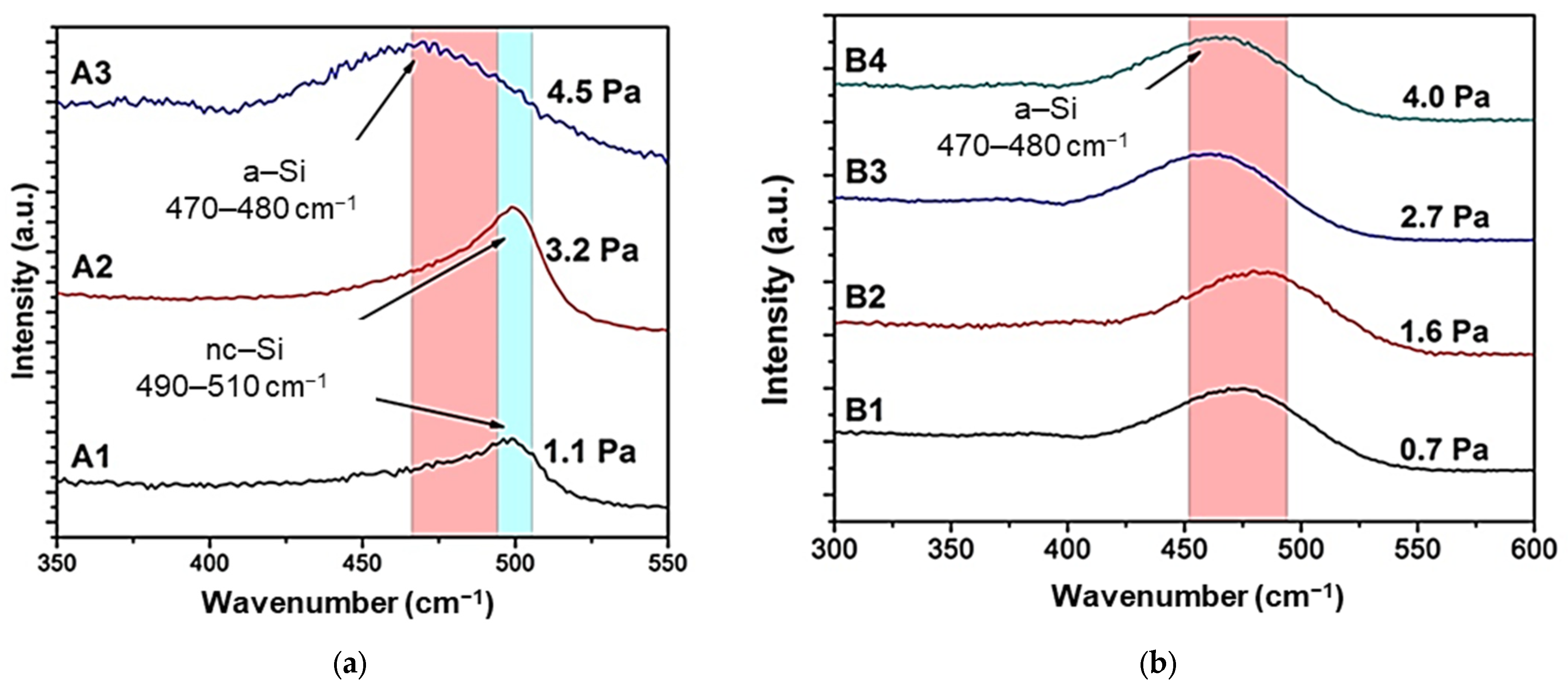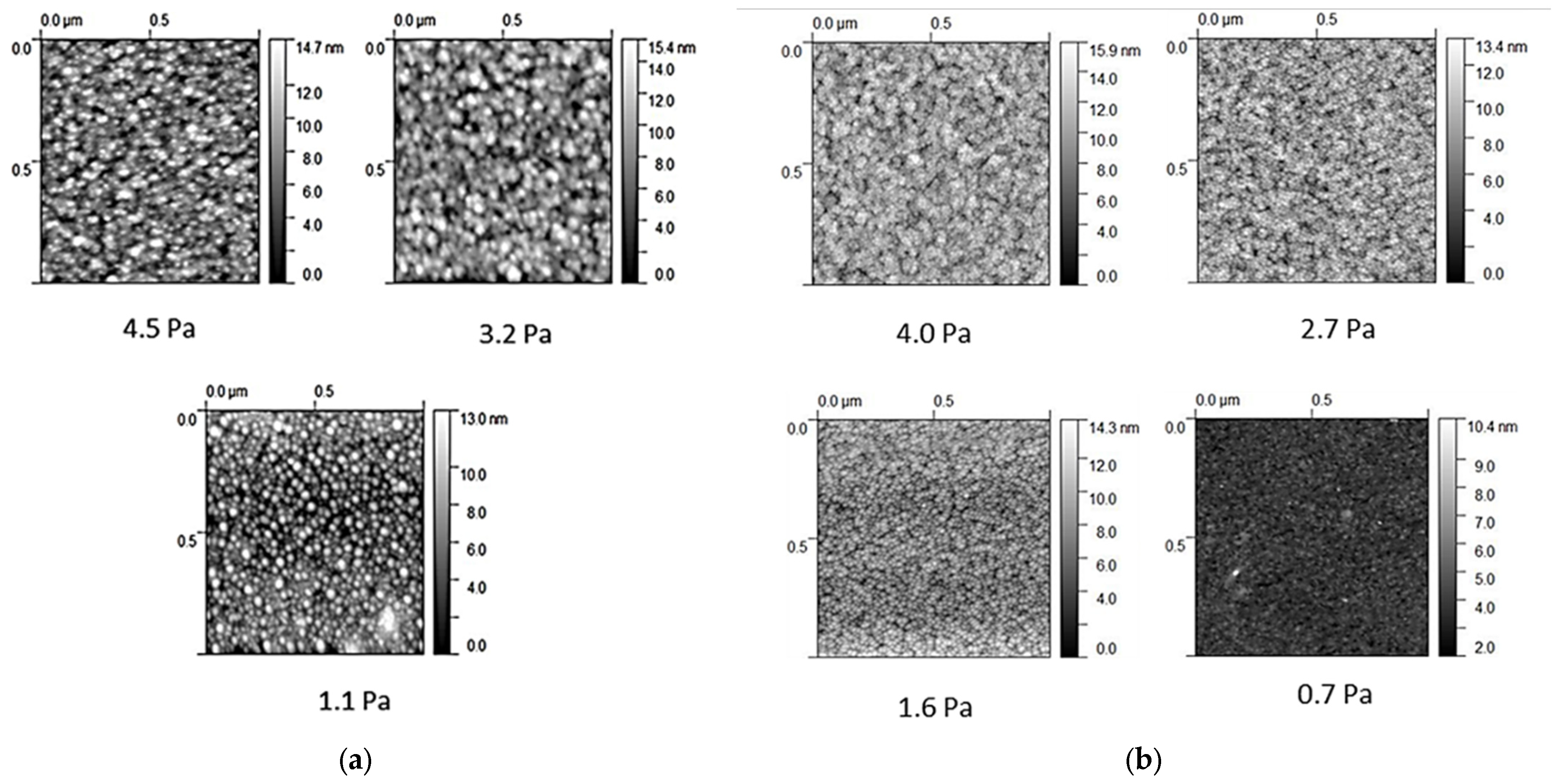Sputtered Non-Hydrogenated Amorphous Silicon as Alternative Absorber for Silicon Photovoltaic Technology
Abstract
:1. Introduction
2. Materials and Methods
3. Results
3.1. Sputtering Deposition of Low-Temperature Non-Hydrogenated Amorphous Silicon (Precursor)
3.2. Effect of Deposition Conditions and Structure of the Precursor Material on the Subsequent Crystallized a-Si
4. Conclusions
Author Contributions
Funding
Institutional Review Board Statement
Informed Consent Statement
Data Availability Statement
Acknowledgments
Conflicts of Interest
References
- El Chaar, L.; Iamont, L.A.; El Zein, N. Renewable of photovoltaic technologies. Renew. Sust. Energy Rev. 2011, 15, 2165–2175. [Google Scholar] [CrossRef]
- Parida, B.; Iniyan, S.; Goic, R. A review of solar photovoltaic technologies. Renew. Sust. Energy Rev. 2011, 15, 1625–1636. [Google Scholar] [CrossRef]
- Yang, J.; Banerjee, A.; Guha, S. Amorphous silicon- based photovoltaics—From earth to the final frontier. Sol. Energy Mater. Sol. Cells 2003, 78, 597–612. [Google Scholar] [CrossRef]
- Wilson, G.M.; Al-Jassim, M.; Metzger, W.K.; Glunz, S.W.; Verlinden, P.; Xiong, G.; Mansfield, L.M.; Stanbery, B.J.; Zhu, K.; Yan, Y.; et al. The 2020 photovoltaic technologies roadmap. J. Phys. D Appl. Phys. 2020, 53, 493001. [Google Scholar] [CrossRef]
- Mauk, M.G. Chapter I-2-D—Thin Crystalline and Polycrystalline Silicon Solar Cells. In McEvoy’s Handbook of Photovoltaics: Fundamentals and Applications; Academic Press: Cambridge, MA, USA, 2018; pp. 159–231. [Google Scholar] [CrossRef]
- Bayod-Rújula, A.A. Chapter 8—Solar photovoltaics (PV). In Solar Hydrogen Production: Processes, Systems and Technologies; Academic Press: Cambridge, MA, USA, 2019; pp. 237–295. [Google Scholar] [CrossRef]
- Haschke, J.; Amkreutz, D.; Rech, B. Liquid phase crystallized silicon on glass: Technology, material quality and back contacted heterojunction solar cells. Jpn. J. Appl. Phys. 2016, 55, 04EA04. [Google Scholar] [CrossRef]
- Eisenhauer, D.; Trinh, C.T.; Amkreutz, D.; Becker, C. Light management in crystalline silicon thin-film solar cells with imprint-textured glass superstrate. Sol. Energy Mater. Sol. Cells 2019, 200, 109928. [Google Scholar] [CrossRef]
- Sonntag, P.; Presissler, N.; Bokalic, M.; Trahms, M.; Haschke, J.; Schalatmann, R.; Topic, M.; Rech, B.; Amkreutz, D. Silicon solar cells on glass with power conversion efficiency above 13% at thickness below 15 micrometer. Sci. Rep. 2017, 7, 873. [Google Scholar] [CrossRef] [PubMed]
- Becker, C.; Amkreutz, D.; Sontheimer, T.; Preidel, V.; Lockau, D.; Haschke, J.; Jogschies, L.; Klimm, C.; Merkel, J.J.; Plocica, P.; et al. Polycrystalline silicon thin-film solar cells: Status and perspectives. Sol. Energy Mater. Sol. Cells 2013, 119, 112–123. [Google Scholar] [CrossRef]
- Jia, G.; Andrä, G.; Gawlik, A.; Schönherr, S.; Plentz, J.; Eisenhawer, B.; Pliewischkies, T.; Dellith, A.; Falk, F. Nanotechnology enhanced solar cells prepared on laser-crystallized polycrystalline thin films (<10 µm). Sol. Energy Mater. Sol. Cells 2014, 126, 62–67. [Google Scholar] [CrossRef]
- Trinh, C.T.; Schalatmann, R.; Rech, B.; Amkreutz, D. Progress in and potential of liquid phase crystallized silicon solar cells. Sol. Energy 2018, 175, 75–83. [Google Scholar] [CrossRef] [Green Version]
- Preissler, N.; Amkreutz, D.; Sonntag, P.; Trahms, M.; Schlatmann, R.; Rech, B. Inferface engineering for liquid-phase crystallized-silicon solar cells on glass. Sol. RRL. Adv. Sci. News 2017, 1, 1700015. [Google Scholar] [CrossRef]
- Amkreutz, D.; Haschke, J.; Häring, T.; Ruske, F.; Rech, B. Conversion efficiency and process stability improvement of electron beam crystallized thin film silicon solar cells on glass. Sol. Energy Mater. Sol. Cells 2014, 123, 13–16. [Google Scholar] [CrossRef]
- Bailey, L.R.; Proudfoot, G.; Mackenzie, B.; Andersen, N.; Karlsson, A.; Ulyashin, A. High rate amorphous and crystalline silicon formation by pulsed DC magnetron sputtering deposition for photovoltaics. Phys. Stat. Sol. A 2015, 212, 42–46. [Google Scholar] [CrossRef]
- Sircar, R.; Tripathi, B.; Gupta, S. Design and simulation of thin-film silicon quantum well photovoltaic cell. J. Nano-Electron. Phys. 2011, 3, 11–18. [Google Scholar]
- Moravej, M.; Babayan, S.E.; Nowling, G.R.; Yang, X.; Hicks, R.F. Plasma enhanced chemical vapor deposition of hydrogenated amorphous silicon at atmospheric pressure. Curr. Appl. Phys. 2010, 10, 5354–5356. [Google Scholar] [CrossRef] [Green Version]
- Thornton, J.A. Influence of apparatus geometry and deposition conditions on the structure and topography of thick sputtered coatings. J. Vac. Sci. Technol. 1974, 11, 666–670. [Google Scholar] [CrossRef]
- Hashim, S.B.; Mahzan, N.H.; Herman, S.H.; Rusop, M. Room-temperature deposition of silicon thin films by RF magnetron sputtering. Adv. Mater. Res. 2012, 576, 543–547. [Google Scholar] [CrossRef]
- Choi, S.G.; Wang, S.-J.; Park, H.-H.; Jang, J.-N.; Hong, M.; Kwon, K.-H.; Park, H.-H. Properties of amorphous silicon thin films synthesized by reactive particle beam assisted chemical vapor deposition. Thin Solid Film. 2010, 518, 7372–7376. [Google Scholar] [CrossRef]
- Müllerová, J.; Prusáková, L.; Netralová, M.; Vavrunková, V.; Sutta, P. A study of optical absorption in amorphous hydrogenated silicon thin films of varied thickness. Appl. Surf. Sci. 2010, 256, 5667–5671. [Google Scholar] [CrossRef]
- Liu, K.; Yao, W.; Wang, D.; Ba, D.; Liu, H.; Gu, X.; Meng, D.; Du, G.; Xie, Y.; Ba, Y. A study of intrinsic amorphous silicon thin film deposited on flexible polymer substrates by magnetron sputtering. J. Non-Cryst. Solids 2016, 449, 125–132. [Google Scholar] [CrossRef]
- Houben, L.; Lyusberg, P.; Hapke, R.; Carius, F.; Finger, F.; Wagner, H. Structural properties of microcrystalline silicon in the transition from highly crystalline to amorphous growth. Philos. Mag. A 1998, 77, 1447–1460. [Google Scholar] [CrossRef]
- Alfonso, E.; Olaya, J.; Cubillos, G.I. Thin film growth through sputtering technique and its applications. In Crystallization—Science and Technology; IntechOpen: London, UK, 2012; Available online: https://www.intechopen.com/books/crystallization-science-and-technology/thin-film-growth-through-sputtering technique-and-its-applications (accessed on 19 September 2012)ISBN 978-953-51-0757-6. [CrossRef] [Green Version]
- Cheng, Q.; Xu, S.; Ostrikov, K.K. Structural evolution of nanocrystalline silicon thin films synthesized in high density, low-temperature reactive plasmas. Nanotechnology 2009, 20, 215606. [Google Scholar] [CrossRef]
- Jun, S.; Melechko, A.V.; Simpson, M.L. Low-temperature solid-phase crystallization of amorphous silicon thin films deposited by rf magnetron sputtering with substrate bias. Appl. Phys. Lett. 2006, 89, 022104. [Google Scholar] [CrossRef] [Green Version]
- Qin, Y.; Feng, T.; Li, Z.; Sun, Z. Structural, optical and electrical properties of amorphous silicon thin films prepared by sputtering with different targets. Appl. Surf. Sci. 2011, 275, 7990–7996. [Google Scholar] [CrossRef]
- Zanatta, A.R. Revisiting the optical bandgap of semiconductors and the proposal of a unified methodology to its determination. Sci. Rep. 2019, 9, 11225. [Google Scholar] [CrossRef] [PubMed] [Green Version]
- Márquez, E.; Blanco, E.; García-Váquez, C.; Díaz, J.M.; Saugar, E. Spectroscopic ellipsometry study of non-hydrogenated fully amorphous silicon films deposited by room-temperature radio-frequency magnetron sputtering on glass: Influence of the argon pressure. J. Non-Cryst Solids. 2020, 547, 120305. [Google Scholar] [CrossRef]




| Code Sample | Substrate Temperature (°C) | RF Power (W) | Pressure (Pa) |
|---|---|---|---|
| A 1 | RT | 525 | 1.1 |
| A 2 | RT | 525 | 3.2 |
| A 3 | RT | 525 | 4.5 |
| B 1 | 325 | 450 | 0.7 |
| B 2 | 325 | 450 | 1.6 |
| B 3 | 325 | 450 | 2.7 |
| B 4 | 325 | 450 | 4.0 |
| Code Sample | Pressure (Pa) | RMS (nm) |
|---|---|---|
| A 1 | 1.1 | 1.63 |
| A 2 | 3.2 | 1.89 |
| A 3 | 4.5 | 1.93 |
| B 1 | 0.7 | 0.64 |
| B 2 | 1.6 | 0.69 |
| B 3 | 2.7 | 1.20 |
| B 4 | 4.0 | 1.25 |
| Code Sample | Pressure (Pa) | EG (eV) | n @ 1 eV |
|---|---|---|---|
| A 1 | 1.1 | 1.18 | 3.75 |
| A 2 | 3.2 | 1.35 | 3.40 |
| A 3 | 4.5 | 1.36 | 3.17 |
| B 1 | 0.7 | 1.42 | 3.60 |
| B 2 | 1.6 | 1.37 | 3.65 |
| B 3 | 2.7 | 1.47 | 3.70 |
| B 4 | 4.0 | 1.48 | 3.50 |
| Code Sample | Irradiance (W/cm2) | Scan Speed (nm/min) | Grain Size (nm) | |
|---|---|---|---|---|
| A 1 | 950 | 400 | 84 | 50 |
| A 1 | 1220 | 600 | 84 | 71 |
| B 2 | 1385 | 1000 | 91 | 70 |
| B 2 | 1630 | 1000 | 96 | 2450 |
Publisher’s Note: MDPI stays neutral with regard to jurisdictional claims in published maps and institutional affiliations. |
© 2021 by the authors. Licensee MDPI, Basel, Switzerland. This article is an open access article distributed under the terms and conditions of the Creative Commons Attribution (CC BY) license (https://creativecommons.org/licenses/by/4.0/).
Share and Cite
Fernández, S.; Gandía, J.J.; Saugar, E.; Gómez-Mancebo, M.B.; Canteli, D.; Molpeceres, C. Sputtered Non-Hydrogenated Amorphous Silicon as Alternative Absorber for Silicon Photovoltaic Technology. Materials 2021, 14, 6550. https://doi.org/10.3390/ma14216550
Fernández S, Gandía JJ, Saugar E, Gómez-Mancebo MB, Canteli D, Molpeceres C. Sputtered Non-Hydrogenated Amorphous Silicon as Alternative Absorber for Silicon Photovoltaic Technology. Materials. 2021; 14(21):6550. https://doi.org/10.3390/ma14216550
Chicago/Turabian StyleFernández, Susana, J. Javier Gandía, Elías Saugar, Mª Belén Gómez-Mancebo, David Canteli, and Carlos Molpeceres. 2021. "Sputtered Non-Hydrogenated Amorphous Silicon as Alternative Absorber for Silicon Photovoltaic Technology" Materials 14, no. 21: 6550. https://doi.org/10.3390/ma14216550






